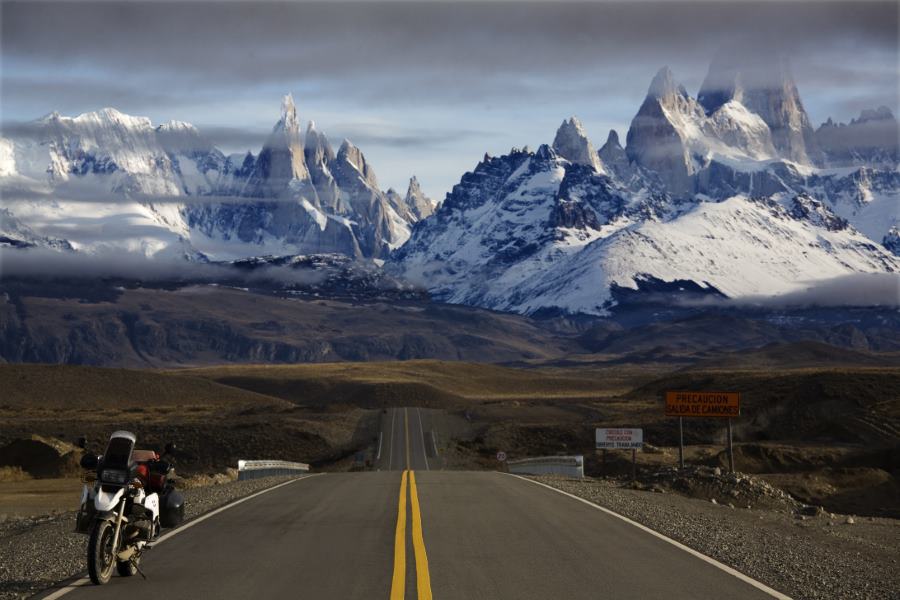I've been a member of HU for years now, reading and dreaming, being inspired by all of you who take the plunge and go all in on that RTW trip, leaving behind everything you've built up to chase the four winds.
So here's our story, at last:
Neda and I got our motorcycle licenses together in spring of 2004, as an engagement present to ourselves. We thought it would be a neat thing to do.
We took day trips, hung out at motorcycle meets, rode on group rides, did track days, took longer motorcycle trips, rode dirt bikes, became motorcycle instructors, took even longer trips, and then dealt with the aftermath, the ensuing ennui of "real life" - the anchor of a home, the jobs and the bills; the maintenance of everything we've accumulated in our collective seven decades on earth.
So the solution seemed logical to us: quit the jobs, sell our home and everything in it, and set out on
THE motorcycle journey with no route planned, no end in sight and no return date in mind.
Here are some pics from our blog:
Jun 14 2012: Escape Velocity
 It all starts with a bike... Actually, this was one of the last things we did to prepare for our trip!
It all starts with a bike... Actually, this was one of the last things we did to prepare for our trip!
 This is what's left of our earthly possessions after a few rounds of Keep, Sell, Throw Away, Give Away. Now to get it all on our bikes...!
This is what's left of our earthly possessions after a few rounds of Keep, Sell, Throw Away, Give Away. Now to get it all on our bikes...!
The preparations were long and tedious, possibly the content of another blog entry, and we did manage to finally leave Toronto two days later than we had planned - See! We're already sticking to our "No Plan" resolution.
Our early Sunday morning ride out of Ontario was a breath of fresh air, after the stifling, hectic bustle of the previous few weeks. No responsibility but to ride and ride and ride. A few things still lingered on my mind, one motorcycle, one SUV still left to sell, and the turnover of keys for the condo when we returned in 2 1/2 weeks. And the weather was beautiful! So unlike all of our other motorcycle trips.
 I've left just enough space for myself between the tank bag and the stuff piled on the rear seat. Hopefully I don't gain any weight on this trip...
I've left just enough space for myself between the tank bag and the stuff piled on the rear seat. Hopefully I don't gain any weight on this trip...
'm taking my trusty R1200GS. It does handle like a pig now with all the weight in the back, the front end feels so light and I have to push the bars a lot harder so I don't run wide in turns. Ack!
 First day's ride
First day's ride
 Picked up some yummy strawberries at Flynn's Corners before hitting the 507
Picked up some yummy strawberries at Flynn's Corners before hitting the 507
We rode all our favorite back roads out of Ontario and knocked on the door of our very good friends in Ottawa, Kevin and Manon, who generously fed us with ice cream in the garage and let us set up our tent in their back yard. Just in case you are thinking they aren't very good friends at all, I am deathly allergic to their two cats who glared at me with knowing malintent through the screen door of the back porch.
 Coming off the R1200ST's shaft drive, Neda has to get used to lubing her chain drive every evening now. Haha!
Coming off the R1200ST's shaft drive, Neda has to get used to lubing her chain drive every evening now. Haha!
 Cooling off with a little ice cream in the garage
Cooling off with a little ice cream in the garage
 Easing me into camping, backyard-style. Just like a kid.
Easing me into camping, backyard-style. Just like a kid.
I'm not a camping-kinda guy. My idea of roughing it means no fluffy white robe hanging on the back of the bathroom door and no mints on the pillow. Neda, on the other hand, is NatureGirl, so she was really looking forward to getting a lot of outdoor-time.
 Neda and Manon prepare breakfast, while I watch from the back porch.
Neda and Manon prepare breakfast, while I watch from the back porch.
Leaving Kevin and Manon's place, I accidentally left my GPS case lying on the top of one of my saddlebags. The rear is so crowded with all the dry bags, extra fuel tank, toolkit and backpack that it's easy to misplace something back there. By the time I had realized it was missing, it had already been sacrificed to the highway gods.


Kevin: "The only thing this driveway needs is more GSes...!"

GS convention in Kevin and Manon's driveway

















 446Likes
446Likes























 Threaded Mode
Threaded Mode







